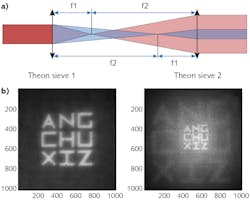Diffractive elements create simple and effective radial shearing interferometer

As a way to test an optic by interferometrically checking its resulting wavefront deformation, a radial shearing interferometer has one great advantage over the usual Fizeau interferometer: it does not require a separate reference wavefront. Instead, it splits the beam into two similar or identical beams, radially magnifies or demagnifies one beam, and interferes the two beams with each other. Analyzing the results, while different from a conventional interferometric setup, is straightforward.
However, although a radial shearing interferometer does not need a separate reference wavefront, its optics tend to be at least as complicated than conventional interferometers that do produce a reference wavefront. Now, optical engineers at Shanghai Institute of Optics and Fine Mechanics (Shanghai, China) and the China Center of Materials Science and Optoelectronics Engineering (Beijing, China) have proposed a solution to this problem that relies on so-called “photon sieves” to not only simplify the optics, but also result in a common-path setup.1
Some pre-existing radial shearing interferometers have had a Keplerian telescope (a standard refracting telescope) inserted in one arm of a Mach-Zehnder-type interferometer to radially magnify the wavefront; other versions have had a Twyman-Green interferometric setup (with a beamsplitter) and different magnifications for each arm. These additional optics, plus the need to have two separate interferometer arms in the first place, are what make a radial shearing interferometer complex and finicky, and difficult to build in large sizes.
Instead, the Chinese group has proposed a new kind of telescope structure called the Theon-Kepler bifocal telescope. It superficially resembles a Keplerian telescope formed of two convex lenses. However, the “lenses” are replaced with photon sieves, which are flat plates punctured with many holes of precise and differing sizes and positions, generally forming something akin to a diffractive amplitude-only zone plate. Photon sieves can be manufactured at large volumes and low cost using photolithography.
Theon sieve
The researchers call their photon sieve a “Theon sieve” because its hole pattern follows a certain aperiodic mathematical relation that descends from the ancient Greek Theon of Smyrna’s proposed method to find rational approximations to the square root of two, called “Theon’s ladder.” Such a photon sieve, which serves as a convex lens, simultaneously has two different foci along the optical axis. Given a collimated input beam, a pair of identical Theon sieves with the proper geometry produces two output beams of different magnification, both beams overlapping and aligned on the optical axis (see figure).
Because the Theon sieve is an amplitude-only diffractive optical element (rather than phase-sensitive), its performance is not wavelength-sensitive, say the researchers. Its big disadvantage is that the diffraction efficiency is low. In the experiment, the researchers chose a LED as the light source and used a multiwavelength superposition method to replace multiexposure recording of a monochrome beam while rotating a diffuser. To test the system’s dual magnification ability, a 2592 × 2048 pixel CMOS imager captured the output beam with and without a spatial filter (pinhole) placed at the first focus.
Two applications were investigated: radial-shearing wavefront measurement, and radial-shearing interferometrical imaging. In the first, an input beam previously characterized with Zernike coefficients up to order 21 and peak-to-valley (P-V) of 0.178 λ was measured with the setup; the measured wavefront accurately matched its previous characterization (see the reference paper for details). In the test of radial-shearing interferometrical imaging, a phase-only object with a P-V of 2.333 λ and size of a few millimeters was accurately imaged.
The researchers note that because this diffractive Theon sieve-based setup is amplitude-only, it can be used at very short wavelengths, such as extreme ultraviolet (EUV) and soft x-rays, where transmissive optical materials are few and far between.
REFERENCE
1. Y. Li et al., Appl. Opt. (2020); https://doi.org/10.1364/ao.392574.
About the Author
John Wallace
Senior Technical Editor (1998-2022)
John Wallace was with Laser Focus World for nearly 25 years, retiring in late June 2022. He obtained a bachelor's degree in mechanical engineering and physics at Rutgers University and a master's in optical engineering at the University of Rochester. Before becoming an editor, John worked as an engineer at RCA, Exxon, Eastman Kodak, and GCA Corporation.
